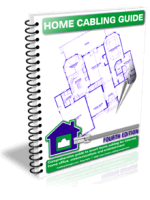ANSI/TIA/EIA-569-A
STANDARD
This standard titled “Commercial Building Standard for
Telecommunications Pathways and Spaces” is a joint publication of
ANSI/TIA/EIA. Its current version (ANSI/TIA/EIA/-569-B) was published
in October 1, 2004 and describes EMI aspects in Article 10.3
“Horizontal pathway separation from EMI sources”.
The scope of the standard's requirements is as folows:
10.3.1 Separation between telecommunications and power cables
Co-installation of
telecommunications cable and power cable is governed by applicable
electrical code for safety. For minimum separation requirements of
telecommunications cable from typical branch circuits (120/240V, 20A),
Article 800-52 of ANSI/NFPA 70 (Ref D.3) shall be applied, for example:
- separation from power conductors;
- separation and barriers within raceways; and
- separation within outlet boxes or compartments.
10.3.2 Other related requirements
The following additional requirements shall also be met:
- the building itself shall be suitably protected from lightning (see ANSI/NFPA 780 (Ref D.4));
- surge protection shall be applied at the electrical service
entrance (see Article 280 of ANSI/NFPA 70 and section 9.11 of ANSI/IEEE
(Ref. D1));
- ANSI/TIA/EIA – 607 Commercial Building Grounding and Bonding Requirements for Telecommunications shall be followed; and
- faulty electrical wiring shall be corrected (see section 7.5 of ANSI/IEEE 1100).
10.3.3 Reducing noise coupling
In order to further reduce noise
coupling from sources such as electrical power wiring, radio frequency
(RF) sources, large motors and generators, induction heaters, and arc
welders, the following additional precautions should be considered:
- Increased physical separation.
- Electrical branch circuit line, neutral, and grounding
conductors should be maintained close together (e.g., twisted,
sheathed, taped, or bundled together) for minimizing inductive coupling
into telecommunications cabling.
- Use of surge protectors in branch circuits that can further
limit the propagation of electrical surges. Follow guidelines in
section 9.11.2 of ANSI/IEEE 1100.
- Use of fully enclosed, grounded metallic raceway of
grounded conduit or use of cable installed close to a grounded metallic
surface that will also limit inductive noise coupling. Refer to clause
5.5.2.7 of ANSI/TIA/EIA – 607 and section 9 of ANSI/IEEE 1100.
The original version of this standard contains a special table titled
“Separation of Telecommunications Pathways from <= 480 V Power
Lines”. This table was deleted from the current version of the
standard, but, nevertheless, remains an important and conservative
reference.
| Condition |
Minimum Separation Distance |
|
<2 kVa |
2-5 kVa |
>5kVa |
| Unshielded power lines or electrical equipment in proximity to open or nonmetal pathways. |
127 mm
( 5 in) |
305 mm
(12 in) |
610 mm
(24 in) |
| Unshielded power lines or electrical equipment in proximity to a grounded metal conduit pathway |
64 mm
(2.5 in) |
152 mm
(6 in) |
305 mm
(12 in) |
| Power lines enclosed in a grounded metal conduit (or equivalent shielding) in proximity to a grounded metal conduit pathway. |
- |
76 mm
(3 in) |
152 mm
(6 in) |
Copyright© 2000-2006 cabling-design.com
|

